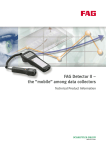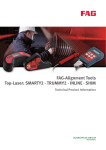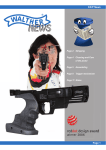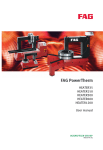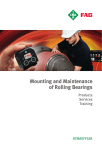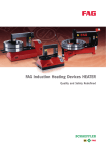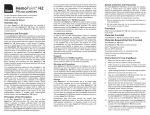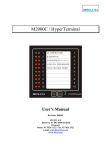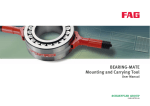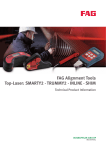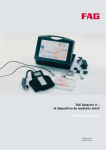Download FAG Detector III – The solution for monitoring and balancing
Transcript
FAG Detector III – The solution for monitoring and balancing Technical Product Information Principle · Operation Condition-based maintenance High functionality – Simple handling Condition-based maintenance means: identifying damage at an early stage, defining planned repairs, making optimum use of bearing life, and achieving considerable reductions in costs. FAG Detector III fulfils these tasks to an optimum degree and is also highly suitable for users without knowledge of vibration technology. FAG Detector III is an offline vibration monitoring system, data collector and operational balancing device all in one. By means of various sensors, it can record the vibrations, temperatures and speeds of machinery. Step by step, the device’s software guides the user through the measurement and balancing procedure. The userfriendly software Trendline then allows easy and effective data analysis. Any incipient damage can thus be detected at a very early stage. As a result, maintenance can be planned and machine availability can be increased. Preventing plant downtime There are many different reasons for unplanned downtime of machinery. However, a not inconsiderable percentage can be attributed, directly or indirectly, to imbalance or misalignment. During operation, imbalance can generate considerable vibrations that lead to secondary damage such as premature bearing wear or fatigue fractures. This results in machine failure and thus unplanned production shutdowns. FAG Detector III is a tool that can be used to not only identify but also easily and efficiently eliminate such conditions. FAG Detector III is thus the ideal entry level device into the world of offline plant monitoring. Advantages of the system – Parallel monitoring of vibration and temperature – Static and dynamic balancing on site – Optimised vibration data recording by means of RFID technology – Wide range of options for analysis and presentation – Simple and easy to use – Excellent price/performance ratio Reasons for unplanned downtime 1 Areas of application · Measurement Areas of application Machine vibrations are a good indicator for the condition of a machine. FAG Detector III can be used to monitor machine vibrations according to ISO 10816 and the condition of rolling bearings by means of the demodulated signal detection method. FAG Detector III is thus a highly suitable device for the detection of • imbalance and misalignment • rolling bearing damage • gearbox damage (tooth sets) Typical areas of application include the monitoring of • pumps • electric motors • fans • machine tools • compressors • gearboxes • spindles • etc. For the measurement procedure, the user selects this measurement location in the configuration system of FAG Detector III and measurement is started. At the beginning the speed is measured, which should be constant during measurement (at least 40 or 600 rpm for ISO 10816). The device records the sensor signals according to the selected bandwidths and calculates the parameters. For each configuration, FAG Detector III compares the measured parameters with the main alarm limit values defined for this measurement location. If a threshold value is exceeded, this is displayed directly on the device. For conspicuous parameters, the causes can be recognised from the demodulated and raw signal spectrum. With the aid of trend analysis, the user can estimate when an alarm will probably occur. When an alarm is triggered, an alarm report can be automatically generated and printed out. In order to allow comparison of values in offline measurement, it must be ensured that approximately equivalent conditions (load, speed etc.) are present. After reference measurement, measurements should be carried out at regular intervals. Measurement and analysis of machine condition FAG Detector III picks up vibration signals at predetermined measuring points and calculates the RMS values for vibration velocity, vibration acceleration and the demodulation. These characteristic values describe the condition of the machine and component and are presented in greater detail in the table on page 6. The sensor should be positioned as close as possible to the point to be measured. In general, it is attached to the machine by means of the screw-mounted magnetic foot. 2 Presentation of measurement data in the Trendline software Route planning · Bearing database Route planning The user can model the plant structure on a PC using the Trendline software. Within these configurations, routes can be defined, for example for individual days of the week or by machine type. Before measurement, the selected route is transferred to FAG Detector III. After a measurement round, all the recorded data are transferred to the Trendline software for evaluation, analysis and presentation by means of diagrams and tables. Trendline bearing database The integrated bearing database (containing approx. 20 000 bearings from various manufacturers) allows considerably simplified and shortened analysis of the measured data. In tandem with F’IS Viewer, the bearing database offers a perfect combination for assessing machine condition. Significant features can be recognised and allocated to the appropriate components at first sight. A separate bearing list can be filed for each measuring point. This offers the option of checking several bearing kinematic frequencies efficiently at one measurement point. The bearing database can be expanded individually by each user to include further entries. Bearing database 3 RFID · Report Automatic detection of measuring points – RFID With the new, optional functionality of automatic measuring point detection, recording of measurement values using FAG Detector III is faster, simpler and more user-friendly. With the aid of RFID technology, the device automatically detects the measuring points if these are equipped with RFID tags and jumps to the corresponding point in the configuration. Measurement of the wrong assembly and erroneous allocation of measuring points are thus a thing of the past. The employee only needs to start and store measurement using FAG Detector III – no other action is required. Nothing could be simpler. The RFID technology can be easily retrofitted to existing FAG Detector III devices. Run-up/coast-down Configurable report Run-up/coast-down is used to determine resonance points. In a diagram (Bode plot), both the amplitude and the phase during run-up or coast-down are laid off over speed and presented in diagrammatic form in F’IS Viewer. The resonance ranges determined can then be marked diagrammatically and allocated to any balancing configuration. In the worst case, balancing in the resonance range can lead to machine damage. A very useful feature of the Trendline software is the expanded report generator. This offers maintenance personnel in the company as well as external service providers using FAG Detector III the possibility of achieving seamless documentation of measurement results. The report generator makes it possible to prepare different reports matched specifically to individual customer requirements. All the information present in the system can be used for the report, including time signals, trend curves and alarm data. Report generation 4 Features · Ordering designation and scope of delivery Operating benefits Ordering designation and scope of delivery Detector III is available without and with automatic measuring point detection (RFID). The Balancing Kit and accessories are equally suitable for both devices. • Complete package • Static and dynamic balancing (1 and 2 planes) • Monitoring functions: – ISO 10816 – temperature – general vibration condition – rolling bearing condition – data collector for up to 1 600 measurement points – storage of up to 300 time signals • Portable, handy, easy to use diagnostic device • Integrated database with approx. 20 000 entries • Operation with one hand using 21 keys • Soft keyboard resistant to dust and spray water • Headset jack for acoustic noise assessment • Storage and display of up to 4 measurement values per measuring point for straightforward condition assessment • RFID reader (retrofittable) for readout of RFID transponders • Configurable report generator • E-Mail service • Software • Sensor cable length up to 50 m Ordering designation DETECT3-KIT* Scope of delivery: • Basic device with rechargeable battery • Acceleration sensor with magnetic foot • Temperature sensor • Charger • PC data cable (serial/USB) • User manual • Protective bag with holder for temperature sensor • PC software Trendline • Case DETECT3.BALANCE-KIT DETECT3-KIT Ordering designation DETECT3-KIT-RFID** Scope of delivery: • As DETECT3-KIT • RFID Reader (integrated in basic device) • RFID tags Ordering designation DETECT3.BALANCE-KIT*** Scope of delivery: • Acceleration sensor with magnetic foot and sensor cable • Trigger sensor (optical and inductive) • Balance • Magnetic holder for trigger sensor • Extension for magnetic holder • Cable for trigger sensor (length 10 m) • Reflex mark for trigger sensor • Dongle for activation of balancing function • Case Accessories • Sensor extension cables of lengths of 5 m and 15 m are available on request • Further RFID tags are available on request Ordering designation for countries outside Europe * FIS.DETECTORIII.KIT ** FIS.DETECTORIII.KIT.RFID *** FIS.DETECTORIII.BALANCING.KIT 5 Selection of parameters Selection of parameters Possible parameters and signal curves for each measuring point Measurement range/resolution Frequency range Display Parameter: vibration velocity to ISO 10816 (VDI 2056) (broadband RMS value for vibration velocity) for general assessment of machine condition to ISO 10816 ISO 10816 0 to 5,52 m/s3) at 10 Hz 0 to 55,2 mm/s3) at 1 kHz 10 Hz to 1 kHz Detector and PC Parameter: vibration velocity (freely selectable) (RMS value for vibration velocity, e.g. for detection of imbalance and misalignment) Vsel 0 to 5,52 m/s3) at 10 Hz 0 to 55,2 mm/s3) at 1 kHz Freely selectable up to set TP1) (max. 20 kHz) Detector and PC Parameter: acceleration (broadband RMS value for vibration acceleration, e.g. for monitoring of gearboxes) Aeff 0 to 37 g3) 2 kHz – up to set TP1) (max. 20 kHz) Detector and PC Parameter: acceleration (freely selectable) (e.g. for selective gear tooth monitoring) Asel 0 to 37 g3) Freely selectable up to set TP1) (max. 20 kHz) Detector and PC Parameter: demodulated signal (RMS value of demodulated signal up to 100/1000 Hz, e.g. for monitoring of rolling bearing condition) Deff 0 to 37 g3) Freely selectable up to set TP1) (max. 20 kHz) Detector and PC Parameter: demodulated signal (freely selectable) (e.g. for selective monitoring of rolling bearing condition) Dsel 0 to 37 g3) Freely selectable up to set TP1) (max. 20 kHz) Detector and PC Time signal of vibration acceleration up to low-pass cut-off frequency, 4 096 or 8 192 values ±50 g3) 0,1 Hz to 20 kHz 2) PC Demodulated time signal up to set low-pass cut-off frequency, 4 096 or 8 192 values ±50 g3) 0,1 Hz to 20 kHz 2) PC Frequency spectrum (Fourier transform) of time signal for vibration velocity up to set low-pass cut-off frequency ±5,52 m/s3), 0,3 Hz to 20 kHz 2) resolution: TP · 2,56 / quantity of values4) (0,0625 Hz to 12,5 Hz) PC Frequency spectrum (Fourier transform) of time signal for vibration acceleration up to set low-pass cut-off frequency ±50 g3), 0,1 Hz to 20 kHz 2) resolution: TP · 2,56 / quantity of values4) (0,0625 Hz to 12,5 Hz) PC Frequency spectrum (Fourier transform) of time signal for demodulated signal or up to set low-pass cut-off frequency ±25 g3), 0,1 Hz to 20 kHz 2) resolution: TP · 2,56 / quantity of values4) (0,0625 Hz to 12,5 Hz) PC Measurement point temperature Temp = –20 °C to +550 °C – Detector and PC Crest factor – Calculation from time Detector and PC signal for acceleration (up to TP) Speed 30 to 10 000 rpm 0,5 Hz to 166 Hz Detector and PC 1) TP = low-pass cut-off frequency (200, 500 Hz, 1, 2, 5, 10, 20 kHz) Lower limit frequency as a function of set low-pass cut-off frequency (lower limit frequency = TP/number of lines · 2,56) 3) 100 mV/g sensor 4) Quantity of values: 4 096 (at 1600 FFT lines) or 8 192 (at 3 200 FFT lines) 2) On the PC, the user can specify for each measuring point whether and under what conditions certain time signals are to be stored. Three different time signals can be measured, namely vibration velocity (0,1 Hz to TP, scan rate = 2,56 · TP) vibration acceleration (0,1 Hz to TP, scan rate = 2,56 · TP) and demodulated signal (0 Hz to TP , scan rate = 2,56 · TP). FAG Detector III can store up to 300 time signals. 6 Technical data Data collection Measurement ranges Acceleration/vibration velocity 0,1 Hz to TP 1) 0,1 Hz to 200 Hz; 0,1 Hz to 500 Hz; … Demodulated signal 0 Hz to TP 1) Low-pass cut-off frequencies 200, 500 Hz, 1, 2, 5, 10, 20 kHz High-pass (demodulated signal branch) 750 Hz Temperature –20 °C to +550 °C (temperature range as a function of sensor used, freely configurable input) Parameters (2 kHz to TP 1) ), RMS value for vibration acceleration RMS value for vibration acceleration in freely definable frequency range ISO 10816 (10 kHz to 1 kHz), RMS value for vibration velocity V sel RMS value for vibration velocity in freely definable frequency range (frequency band as a function of TP 1) ) D eff RMS value for demodulated signal D sel RMS value for demodulated signal in freely definable frequency range Crest factor, speed, temperature Window function Hanning Averaging in frequency range 1–9 (FFT, parameters per channel) Linear Scan rate Max. 51,2 kHz, as a function of set TP 1) A/D converter 16 bit (autoranging), dynamic range >90 db Frequency resolution 1 600, 3 200 lines (0,0625 Hz to 12,5 Hz as a function of set TP 1) ) Automatic measurement point detection RFID 13,56 MHz, ISO 15693, compatible with RFID tags of stated specification Inputs 2 ~ BNC jacks (multiplexer) ICP (4,7 mA), steplessly adjustable sensitivity AC/DC ±5V, impedance >100 kT 1 ~ AUX Tachometer input 5 to 24V, <10 000 rpm (rising or falling flank selectable) IR temperature sensor ±5V, impedance >100 kT (freely configurable) Battery charger Outputs Headset (demodulated signal) RS 232 for data transmission (38,4 kps, 57,6 kps) AUX: supply for trigger sensor (5 V max. 200 mA, 12 V max. 50 mA) 1) A eff A sel TP = low-pass cut-off frequency 7 Technical data Balancing 1 or 2 plane balancing Weight positions: Continuous (0 to 359°) or discrete (4 to 99 positions) Removal of weights: yes/no Balancing measurement type Acceleration, velocity, travel Measurement Peak, peak-to-peak, RMS Balance units g, mm/s, inch/s, μm, mil Weight units gr., oz. (up to 99 999,99 gr. or oz.) General 8 Separate measurements Temperature, speed, headset (demodulated signal) Keyboard Soft keyboard with 21 keys Display Illuminated graphic display (LCD), 128 ~ 64 pixels, 55 mm ~ 33 mm Memory 1 600 measuring points plus 270 time signals (maximum 300 time signals) Power supply NiMh 2 000 mAh, voltage 6 V Dimensions and mass 230 ~ 70(53) ~ 45(53) mm (L ~ B ~ H), approx. 500 g (including battery) Temperature range 0 °C to 50 °C (working temperature) Operating time Approx. 6 to 8 hours continuous operation Housing ABS, IP 40 Protective bag Two compartments, black nylon, carry strap EMC standards – EN61000-4-2/3/6 Firmware Free of charge firmware updates on Internet Available languages: German, English, Finnish, French, Italian, Dutch, Portuguese, Swedish, Slovenian, Spanish and Turkish Software Trendline (updates on Internet) Suitable for Windows 2000/XP Available in: German, English, French, Portuguese and Spanish – configuration of FAG Detector IIII via RS 232 interface – bearing database of approx. 20 000 bearings – graphic presentation of measurement values and curve – trend analysis – presentation of time signals and FFT – display of balancing in tabular and diagrammatic format – configurable report generator Everything from a single source – Customised monitoring solutions for everyone Everything from a single source – customised monitoring solutions for everyone FAG Industrial Services (F'IS) is a full service supplier in the field of condition-based maintenance. With the sourcing of high quality F’IS products, the customer thus gains access to a range of product-related services (see diagram Services). Based on many years’ experience, F’IS knows that customers wishing to change to the concept of continuous condition monitoring have differing needs and requirements. Therefore, F’IS has a comprehensive portfolio of products and services containing both standard and customerspecific solutions that are always developed in close partnership with the customer. The F’IS service portfolio for continuous condition monitoring covers the following areas: • • • • • consultancy installation initial operation system support continuous and regular measurement It is of course the customer who decides which of the available services he wishes to use. For example, he can choose complete monitoring of his plant by F’IS or to have his employees qualified for independent monitoring at their own responsibility through training. Whichever service is selected, the team of F’IS experts is available at any time. If you have any further questions on our services, please contact us directly or visit our website. Services for FAG Detector III 9 98/04/07 Printed in Germany by Druckhaus WEPPERT GmbH Schaeffler KG Every care has been taken to ensure the Postfach 1260 correctness of the information contained 97419 Schweinfurt (Germany) in this publication but no liability can be Georg-Schäfer-Strasse 30 accepted for any errors or omissions. 97421 Schweinfurt (Germany) We reserve the right to make technical Service Hotline: changes. Phone +49 2407 9149-99 © Schaeffler KG · 2007, April Fax +49 2407 9149-59 This publication or parts thereof may not E-Mail [email protected] be reproduced without our permission. Internet www.fis-services.com TPI WL 80-64/2 EA 99,5/04/07 Printed in Germany by Druckhaus WEPPERT GmbH Every care has been taken to ensure the correctness of the information contained Schaeffler Canada Inc. in this publication but no liability can be accepted for any errors or omissions. 2871 Plymouth Drive, Oakville, ON L6H 5S5 Canada Phone Fax We reserve the right to make technical changes. © Schaeffler KG · 2007, April +1 905 829 2750 +1 905 829 2563 www.fis-services.com This publication or parts thereof may not be reproduced without our permission. TPI WL 80-64/2 EC 99/04/07 Printed in Germany by Druckhaus WEPPERT GmbH Every care has been taken to ensure the correctness of the information contained in this publication but no liability can be accepted for any errors or omissions. We reserve the right to make technical Schaeffler Group USA Inc. 200 Park Avenue changes. © Schaeffler KG · 2007, April PO Box 1933 This publication or parts thereof may not Danbury, CT 06813-1933 be reproduced without our permission. USA TPI WL 80-64/2 ED 99,5/04/07 Printed in Germany by Druckhaus WEPPERT GmbH Every care has been taken to ensure the correctness of the information contained Condition Monitoring Services Australia in this publication but no liability can be A division of the Schaeffler Australia Pty Ltd accepted for any errors or omissions. 105 King William Street We reserve the right to make technical Kent Town South Australia 5067 changes. Australia © Schaeffler KG · 2007, April Phone +61 (8) 8366 0700 E-Mail [email protected] Internet www.cmsa.com.au This publication or parts thereof may not be reproduced without our permission. TPI WL 80-64/2 EF
















